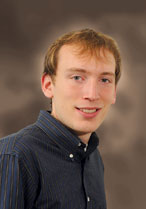Research experience a catalyst for success

RESEARCH | Zachary Ulissi has conducted research at UD and the National Institutes of Health, served as a teaching assistant, co-authored three journal papers and submitted a patent application for a biomedical polarization imaging device—all before finishing his undergraduate studies.
In fact, by the time the University Honors Program student graduated in June, he already had a three-page résumé.
All of Ulissi’s hard work paid off this past spring, when he was selected to receive not only a National Science Foundation (NSF) Graduate Fellowship but also a Department of Energy (DOE) Computational Science Graduate Fellowship. Both coveted awards cover all tuition and fees, pay a generous stipend and include travel and computation funds.
Ulissi faced a dilemma of which to accept, but it was quickly resolved when he learned that he could postpone his plans to pursue a doctorate at the California Institute of Technology, with the DOE fellowship, for a year while he earns a Certificate of Advanced Studies in Mathematics at Cambridge University, supported by the NSF grant.
The applied math program will provide a strong foundation for Ulissi’s doctoral research in catalysis, which will continue the work that he has done at UD with adviser Dion Vlachos, who is the Elisabeth Inez Kelley Professor of Chemical Engineering and director of UD’s Center for Catalytic Science and Technology.
“The concept of a catalyst is simple,” Ulissi says. “It’s an agent that speeds up the rate of a chemical reaction, without being consumed. Catalysts can improve these rates from a crawl to a blink and make a huge range of technology feasible.”
What’s not so simple is determining the mechanisms that make catalysts work. “For this reason,” Ulissi says, “it’s currently impossible to design a catalyst for a specific application like we would expect an engineer to design an engine for a car.”
Most catalysts in consumer devices and machines employ heterogeneous catalysis, where a gas or liquid flow interacts with a solid catalytic surface. One of the most common examples of this is the catalytic converter found in today’s cars, where harmful pollutants in engine exhaust are reacted over a solid catalyst. The catalysts themselves are often very simple, consisting of small particles of metals like platinum or copper.
For catalysts to be effective, the particles need to be roughly a million times smaller than a soccer ball. However, the same small size that makes them so effective also makes understanding and modeling their behavior in realistic situations a formidable challenge.
The solution may lie in an emerging field called multiscale modeling, which is Ulissi’s area of interest. His work involves the development of mathematical models that provide a bridge from the very small scale of the catalyst particles to the relatively large scale of the catalytic converter. Once a multiscale model has been developed, the impact of the properties of catalyst surfaces on overall performance can be determined.
“My research will help to provide answers to some important questions and bring the benefits of catalysis to a range of new applications,” Ulissi says. “Working in a field that allows me to advance our understanding of fundamental processes and directly impact practical problems is a dream come true for me.”
Vlachos calls Ulissi a “phenomenal” student. “His approach can pave the way for rational materials design and replace the current trial-and-error method,” he says.
Article by Diane Kukich, AS ’73, ’84M





